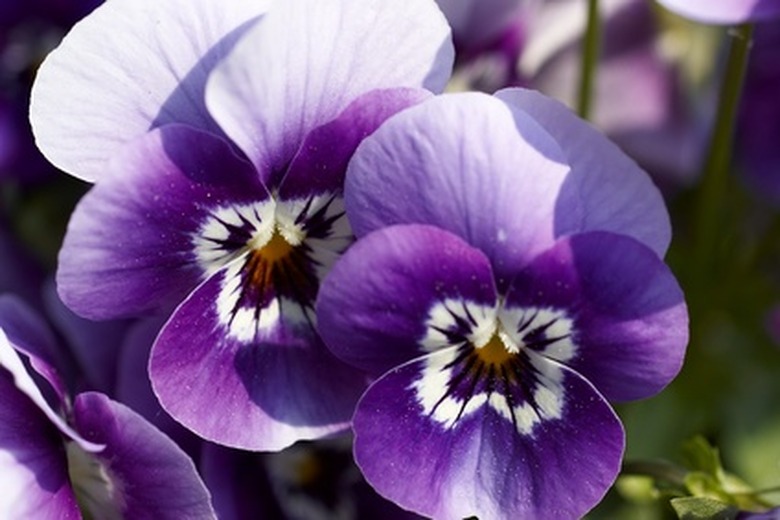Flowers That Look Like Pansies
As some of the earliest annuals to bloom, cheery, open-faced pansies bring smiles to many winter-weary gardeners. Like all members of the Violaceae family, low-growing pansies have five stamens and five petals–the longest of which often has a which has a nectar-filled spur, according to the Discover Life website's Christy Hetzel. As pansies' relatives, violets have smaller, but similar, flowers. A handful of other plants also have pansy-like blooms. Both pansies and violets perform best in cool weather.
Pioneer Violet
Pioneer violet (Viloa glabella) is a common sight in the woods of Alaska and the Pacific Northwest. Standing from 4 to 8 inches high, it has thin stems rising from a clump of vivid green, heart-shaped leaves. Between March and July, pioneer violet brightens the woodland shade with brilliant yellow, purple-veined, pansy-like flowers. Like pansies, the fragrant, outward-facing blooms have nectar-filled, spurred lower petals. The plants love moist to wet locations in partial to full shade.
- As some of the earliest annuals to bloom, cheery, open-faced pansies bring smiles to many winter-weary gardeners.
- Like pansies, the fragrant, outward-facing blooms have nectar-filled, spurred lower petals.
Birdfoot Violet
Another clumping perennial, birdfoot violet (Viola pedata) grows in open woodlands across most of the United States. Four to 10 inches high, it has long-stemmed, green leaves resembling birds' feet. Its May to July flowers are pale blue-violet, with a deeper blue-violet veined lower petal. Orange stamens with yellow anthers, an eye-catching contrast, draw bees and butterflies to the blooms. Birdfoot violet likes well-drained, shady locations and dry, acidic–pH below 6.8–sandy soil, according to the Lady Bird Johnson Wildflower Center.
Canadian White Violet
Canadian white violet (Viola canadensis), a relatively tall 16-inch violet, grows in damp woods from Canada south to Georgia and Arizona. Its yellow-centered, fragrant white flowers appear above dark green, heart-shaped foliage between May and July. Their lower petals have brownish-purple veins. This violet likes full shade and fertile, moist soil with a neutral pH, according to the Lady Bird Johnson Wildflower Center.
- Another clumping perennial, birdfoot violet (Viola pedata) grows in open woodlands across most of the United States.
- Birdfoot violet likes well-drained, shady locations and dry, acidic–pH below 6.8–sandy soil, according to the Lady Bird Johnson Wildflower Center.
Pink Plains Penstemon
One plant with pansy-like blooms that doesn't belonging to the Violet family is pink plains penstemon (Penstermon ambibuus). This mounding perennial native to plains and mesas from Kansas to the Great Basin stands from 12 inches to 3 feet tall. Its thin, erect stems rise from a woody base to produce pale pink, blooms from spring until fall. Their five-petaled, pansy faces sit atop purple-throated tubes, according to the Lady Bird Johnson Wildflower Center.
Plants flower most abundantly during May and sporadically–depending on rainfall amounts–after that. Thread-narrow foliage that conserves moisture makes this penstemon heat and drought-resistant. Wild plants grow in partly shady locations with dry, sandy soil. Note that ingesting this penstemon is toxic.
- One plant with pansy-like blooms that doesn't belonging to the Violet family is pink plains penstemon (Penstermon ambibuus).
- Thread-narrow foliage that conserves moisture makes this penstemon heat and drought-resistant.
